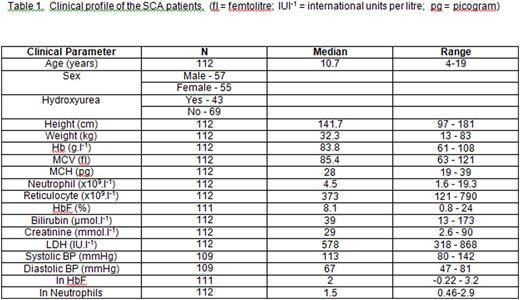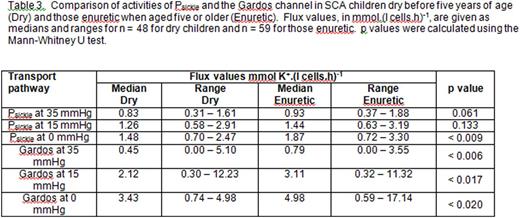Abstract
Background:
Patients with sickle cell disease (SCD) have the abnormal haemoglobin (Hb) HbS in their red blood cells (RBCs). The complications of SCD may be extensive but are markedly variable between patients. Renal damage (sometimes called sickle cell nephropathy, SCN) is a common finding in about a third of children with SCD, a significant number of whom will proceed to renal failure. As yet, it is not possible to predict which children will develop SCN and who would therefore benefit from earlier and aggressive management. Various biomarkers have been investigated but none have proved efficacious. Changes in RBC membrane permeability are closely linked with polymerisation of HbS and, as such, may represent an important early event in pathogenesis.
We postulated that certain RBC characteristics (sickling, K+ transport, PS exposure), which may be inherited independently of the HbS mutation, may correlate with renal pathology, but more importantly, may be identifiable in advance of damage, thereby providing prognostic markers to inform patient management.
Participants and Methods:
Children (>4 years old) with sickle cell anaemia (SCA) were recruited from the paediatric haematology clinic at King's College Hospital in South London, UK. Patients who had received blood transfusion in the preceding four months or who were on medications known to directly alter RBC cation transport (e.g. dipyridamole and Ca2+ channel blockers) were excluded. Patients on hydroxyurea were included. All patients were in steady state, with no acute symptoms requiring treatment for at least seven days. Clinical and laboratory parameters were collected prospectively at routine clinical attendance. Details of enuresis were collected using specifically developed proforma and patients were divided into two groups: those who stopped wetting their bed before the age of five years and those who were still enuretic after five years of age. RBC permeability was assessed using 86Rb+ as a congener for K+ to measure the activity of main cation transport systems involved in RBC dehydration. The activity of RBC transport pathways and percentage of sickling was measured at 100mmHg, 35mmHg, 15mmHg and 0mmHg. Statistical analysis was conducted using IBM-SPSS, New York.
Results: 112 patients of HbSS genotype (SCA) consented to take part in the study. Their clinical profile is summarised Table 1. The percentage of children with enuresis, hypertension and significant albuminuria is shown in Table 2. There was significant correlation between activity of Gardos channel at O2 tensions of 35mmHg, 15mmHg and 0mmHg and enuresis after the age of five years. Psickle activity also showed significant correlation but only in fully deoxygenated RBCs (O2 of 0mmHg.) Table 3.
Conclusion
In conclusion, the present findings emphasise the significance of a thorough appreciation of RBC permeability to the pathogenesis of SCD. Whilst preliminary, these findings are exciting because they show that the activity of a particular transport pathways, abnormally elevated in SCA patients, are associated with enuresis. These findings suggest that the early identification of increased Gardos and Psickle activity may identify children who would benefit from early treatment for nocturnal enuresis.
No relevant conflicts of interest to declare.
Author notes
Asterisk with author names denotes non-ASH members.




This feature is available to Subscribers Only
Sign In or Create an Account Close Modal